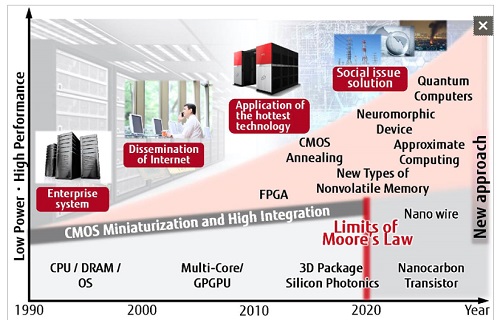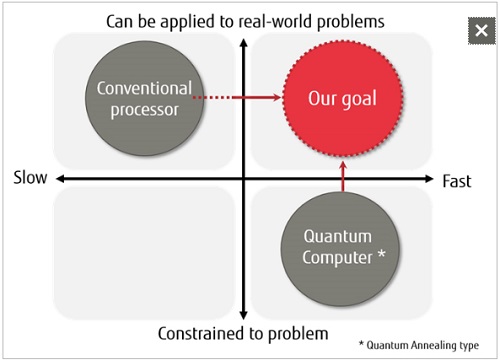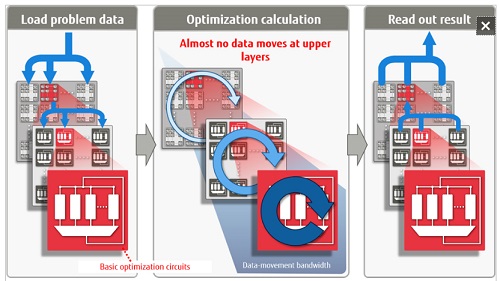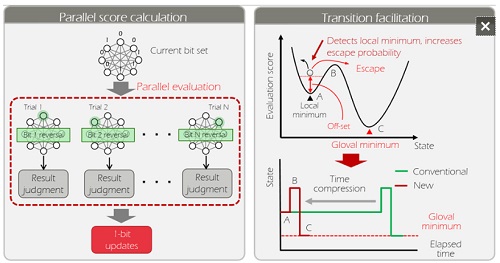|
Fujitsu Laboratories Develops New Architecture that Rivals Quantum Computers in Utility
KAWASAKI, Japan, Oct 20, 2016 - (JCN Newswire) - Fujitsu Laboratories Ltd. today announced that it has collaborated with the University of Toronto to develop a new computing architecture to tackle a range of real-world issues by solving combinatorial optimization problems(1), which involve finding the best combination of elements out of an enormous set of element combinations. This architecture employs conventional semiconductor technology with flexible circuit configurations to allow it to handle a broader range of problems than current quantum computing(2) can manage. In addition, multiple computation circuits can be run in parallel to perform the optimization computations, enabling scalability in terms of problem size and processing speed. Fujitsu Laboratories implemented a prototype of the architecture using FPGAs(3) for the basic optimization circuit, which is the minimum constituent element of the architecture, and found the architecture capable of performing computations some 10,000 times faster than a conventional computer.
Through this architecture, Fujitsu Laboratories is enabling faster solutions to computationally intensive combinatorial optimization problems, such as how to streamline distribution, improve post-disaster recovery plans, formulate economic policy, and optimize investment portfolios. It will also make possible the development of new ICT services that support swift and optimal decision-making in such areas as social policy and business, which involve complex intertwined elements.
Background
 | | Fig. 1: Limits of conventional computing | | |
 | | Fig. 2: Issues in methods to solve combinatorial optimization problems | | |
 | | Fig. 3: The new architecture | | |
 | | Fig. 4: Acceleration using basic optimization circuits | | |
In society, people need to make difficult decisions under such constraints as limited time and manpower. Examples of such decisions include determining procedures for disaster recovery, optimizing an investment portfolio, and formulating economic policy. These kinds of decision-making problems--in which many elements are considered and evaluated, and the best combination of them needs to be chosen-are called combinatorial optimization problems. With combinatorial optimization problems, as the number of elements involved increases, the number of possible combinations increases exponentially, so in order to solve these problems quickly enough to be of any practical utility for society, there needs to be a dramatic increase in computing performance. The miniaturization that has supported the improvements in computing performance over the last 50 years is nearing its limits (Figure 1), and it is hoped that devices will emerge based on completely different physical principles, such as quantum computers.
Fig. 1: Limits of conventional computing
http://www.acnnewswire.com/topimg/Low_FujitsuQuantum11020.jpg
Fig. 2: Issues in methods to solve combinatorial optimization problems
http://www.acnnewswire.com/topimg/Low_FujitsuQuantum21020.jpg
Issues
Conventional processors have a great deal of flexibility in handling combinatorial optimization problems because they process these problems using software, but on the other hand, they cannot solve them quickly. Conversely, current quantum computers can solve combinatorial optimization problems quickly, but because they solve problems based on a physical phenomenon, there is a limitation of only adjacent elements being able to come into contact, so currently they cannot handle a wide range of problems. As a result, developing a new computing architecture that can quickly solve real-world combinatorial optimization problems has been an issue (Figure 2).
About the Technology
Using conventional semiconductors, Fujitsu Laboratories developed a new computing architecture able to quickly solve combinatorial optimization problems. This technology can handle a greater diversity of problems than quantum computing, and owing to its use of parallelization, the size of problems it can accommodate and its processing speed can be increased. Key features of the technology are as follows.
1. A new computing architecture for combinatorial optimization problems
The architecture uses a basic optimization circuit, based on digital circuitry, as a building block. Multiple building blocks are driven, in parallel, in a hierarchical structure (Figure 3). This structure minimizes the volume of data that is moved between basic optimization circuits, making it is possible to implement them in parallel at high densities using conventional semiconductor technology. In addition, thanks to a fully connected structure that allows signals to move freely within and between basic optimization circuits, the architecture is able to handle a wide range of problems.
2. Acceleration technology within the basic optimization circuit
The basic optimization circuit uses techniques from probability theory to repeatedly search for paths from a given state to a more optimal state. This includes a technique that calculates scores for the respective evaluation results of multiple candidates at once, and in parallel, when there are multiple candidates for the next state, which increases the probability of finding the next state (Figure 4, left). It also includes a technique that, when a search process becomes stuck as it arrives at what is called a "local minimum," it detects this state and facilitates the transition to the next state by repeatedly adding a constant to score values that increases the probability of escaping from that state (Figure 4, right). As a result, one can quickly expect an optimal answer.
Fig. 3: The new architecture
http://www.acnnewswire.com/topimg/Low_FujitsuQuantum31020.jpg
Fig. 4: Acceleration using basic optimization circuits
http://www.acnnewswire.com/topimg/Low_FujitsuQuantum41020.jpg
Results
Fujitsu Laboratories implemented the basic optimization circuits using an FPGA to handle combinations that can be expressed as 1,024 bits, and found that this architecture was able to solve problems some 10,000 times faster than conventional processors running a conventional software process called "simulated annealing." By expanding the bit scale of this technology, it can be used to quickly solve computationally intensive combinatorial optimization problems, such as optimizing distribution to several thousand locations, optimizing the profit from multiple projects with a limited budget, or optimizing investment portfolios. It can also be expected to bring about the development of new ICT services that support optimal decision-making at high speed.
Future Plans
Fujitsu Laboratories is continuing to work on improving the architecture, and, by fiscal 2018, aims to have prototype computational systems able to handle real-world problems of 100,000 bits to one million bits that it will validate on the path toward practical implementation.
(1) Combinatorial optimization problems
A class of problems that involves finding the minimum evaluation score for a combination of elements (such as policies, etc.).
(2) Quantum computer
A computing technology that takes advantage of quantum phenomena. A technique called "quantum annealing" has been developed to handle combinatorial optimization problems.
(3) FPGA
Field-programmable gate array. A general purpose device with a circuit layout that can be programmed after manufacture.
About Fujitsu Laboratories
Founded in 1968 as a wholly owned subsidiary of Fujitsu Limited, Fujitsu Laboratories Ltd. is one of the premier research centers in the world. With a global network of laboratories in Japan, China, the United States and Europe, the organization conducts a wide range of basic and applied research in the areas of Next-generation Services, Computer Servers, Networks, Electronic Devices and Advanced Materials. For more information, please see: http://www.fujitsu.com/jp/group/labs/en/.
Contact:Fujitsu Laboratories Ltd.
Computer Systems Laboratory
E-mail: ngcs_qc_press_mem@ml.labs.fujitsu.com
Fujitsu Limited
Public and Investor Relations
Tel: +81-3-3215-5259
URL: www.fujitsu.com/global/news/contacts/
Source: Fujitsu Ltd
Sectors: Semiconductors, Electronics
Copyright ©2024 JCN Newswire. All rights reserved. A division of Japan Corporate News Network. |
Latest Press Release

Mitsubishi Heavy Industries and NGK to Jointly Develop Hydrogen Purification System from Ammonia Cracking Gas
Apr 18, 2024 17:01 JST
| 
Toyota Launches All-New Land Cruiser "250" Series in Japan
Apr 18, 2024 13:39 JST
| 
Fujitsu and Oracle collaborate to deliver sovereign cloud and AI capabilities in Japan
Apr 18, 2024 11:14 JST
| 
Eisai: Research on Treatments for Alzheimer's Disease Based on Its Pathological Mechanisms Recieves Award for Science and Technology (Research Category)
Apr 18, 2024 10:53 JST
| 
All-New Triton Confirmed as First Double-Cab Pickup Truck to Achieve 2024 Five-Star ANCAP Safety Rating
Apr 18, 2024 09:22 JST
| 
Eisai's Antiepileptic Drug Fycompa Injection Formulation Launched In Japan
Apr 17, 2024 16:17 JST
| 
Honda Unveils Next-generation EV Series for China
Apr 17, 2024 12:15 JST
| 
Lexus presents Time at the 2024 Milan Design Week
Apr 16, 2024 18:49 JST
| 
Mitsubishi Corporation Announces Participation in a DAC Project in Louisiana, USA
Apr 16, 2024 14:36 JST
| 
New circuit challenge for TOYOTA GAZOO Racing
Apr 15, 2024 17:21 JST
| 
TOYOTA GAZOO Racing back on asphalt for Croatian challenge
Apr 12, 2024 19:36 JST
| 
Heidelberg Materials North America Announces Latest Milestone in Edmonton CCUS Project
Apr 12, 2024 14:39 JST
| 
MHIAEL Completes Expansion of the its Nagasaki Plant for Manufacture of Aero Engine Combustors
Apr 11, 2024 18:08 JST
| 
Mitsubishi Shipbuilding Acquires Approval in Principle (AiP) from Classification Society ClassNK for Ammonia Fuel Supply System (AFSS)
Apr 11, 2024 17:50 JST
| 
DOCOMO, NTT, NEC and Fujitsu Develop Top-level Sub-terahertz 6G Device Capable of Ultra-high-speed 100 Gbps Transmission
Apr 11, 2024 15:10 JST
| 
Mitsubishi Corporation Announces Completion of Capital Raise by Nexamp
Apr 11, 2024 13:07 JST
| 
Mitsubishi Shipbuilding Receives Order for Ammonia Fuel Supply System for Ammonia-Powered Marine Engine
Apr 10, 2024 16:55 JST
| 
Transgene and NEC Present First Clinical Benefits of Neoantigen Cancer Vaccine, TG4050, in Head & Neck Cancer at AACR 2024
Apr 10, 2024 13:36 JST
| 
DENSO, Companies Initiate Demonstration to Expand Automotive Recycling Process
Apr 09, 2024 19:07 JST
| 
Mitsubishi Power Receives Order from HK Electric for Natural-gas-fired GTCC Power Generation Equipment
Apr 09, 2024 15:04 JST
|
More Latest Release >>
|